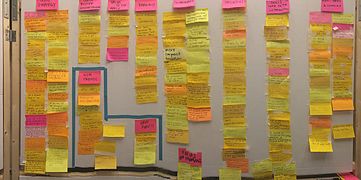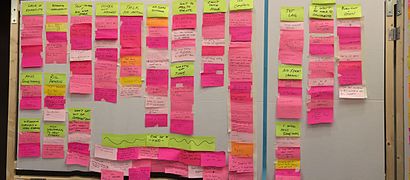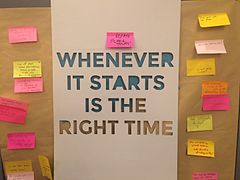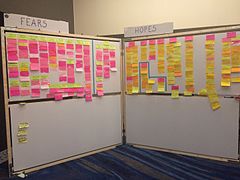Wikimedia Conference 2017/Documentation/Movement Strategy track/Day 1
| WMCON 2017 | Core Conference Program | Fringe Events | Registration & Participants |
Location |
Logistics |
Contact |
Documentation, Reports, Reviews |
The Complexity of a Movement
[edit]Diversity of the Group
[edit]The diversity of the group was highlighted through a series of ‘sociometric’ activities, where participants were asked to position themselves according to certain demographic parameters and criteria. Although voluntary, the facilitators described these activities as “an invitation to stretch our bodies and our thinking,” being fully aware that some people might not feel comfortable with such form of interaction.
In the introduction, facilitators reminded the participants that this group represented only a fraction of the Wikimedians, and that many others were not able to attend. When asked to mention who might be missing, participants answered humorously with names like Obama, Jimmy or Rory, the mascot.
When asked about the complexity of the Wikimedia movement, the majority of the participants raised their hand to agree that Wikimedia is “complex, but in the end it made some sense.” An equal amount of hands supported the idea that Wikimedia might be “impossible” or on the other hand “easy” to understand.
Geography
[edit]To get a sense of the geographic distribution within the group, participants were asked to simulate the map of the world in the room. Questions and comments from participants asking for orientation and meridians illustrated the data-driven culture of the group.
After a round of comments, participants were invited to share with their neighbours a personal story that illustrates why they feel inspired to contribute to Wikimedia.
Language
[edit]The second grouping was by language. Participants were asked to cluster according to the language they feel most comfortable speaking. Around the room, several people expressed in different languages why they were at the conference or something they would like to say about Wikimedia in their native language. Below are some examples of the statements translated into English:
- In Ukranian - “I was invited here.”
- In Hindi - “Thank you for giving us the platform to represent India on the global map.”
- Igbo (a southeast African language spoken in Nigeria) - “On Wikipedia you can find almost anything you want to know about the world.”
- In Yoruba (also spoken in Nigeria) - “Wikipedia is where you can find the soul of all human knowledge.”
Images of the Wikimedia Movement
[edit]Human Sculptures: the Mannequin challenge
[edit]Next, the facilitators proposed that participants complete a mannequin challenge. The instructions were simple: in groups of five, create a collective ‘human statue’ (or frozen scenario) that best represents Wikimedia, and hold that position for approximately one minute, while a camera filmed the room.
Living System Simulation (a.k.a Triangle Exercise)
[edit]The last movement-based activity of the session asked a subset of the participants in the room to simulate what happens within a living system, while the rest of the group formed a large circle around the simulation to observe. The simulation happens by following a very simple instruction: each participant must identify two strangers in the crowd of participants and then try to form an equilateral triangle using themselves and those two other participants, without the knowledge of the others. The natural metaphor that inspires the movement patterns is the murmuration of starlings,[1]</> where each bird keeps connected to those around them without being concerned with the whole movement, remaining in a constant state of flow.

Facilitators asked the group to state what they noticed and what associations they might make with Wikimedia movement based on that activity. Below are some of the comments made by participants.
- Participant: -- “We are like brownian motion.”
- Facilitator: -- “What is that?”
- Participant: -- “Check Wikipedia!”
- [Group laugh]
- “The thing can’t stop moving.”
- “There is no solution. Equilibrium is highly improbable. You always have to move.”
- “Someone will be disappointed for not being in a triangle.”
- “Everything is interconnected.”
- “However we explore trajectories there will always be gaps.”
- “There are differences in our personalities.”
- “We did not all pick the same people.”
- “Taking other people’s agendas into account, even if you had to follow your own agenda too.”
- “You don’t always realise how many people are dependent on your position. You always have some form of invisible power.”
- “People trying to control what was happening and being completely unsuccessful. Sort of like Wikimedia…”
- “I saw two strategies: forming large triangles and small triangles” - a space for the small initiatives and the big initiatives
- “Lots of isosceles and acute triangles” -- initiates don’t always take the shape we expected
- “Dynamic chaos. When one moves, the others move.”
- “Feeling like running after someone that was running away from me.”
- “We were dancing a little”
- “Feeling more interested in who wanted to create a triangle”
- “Using gestures to let others know who they were connected to.” - Emerging cooperation to control the pattern
Hopes, Fears and Something Else
[edit]Each participant was asked to write a hope (yellow or orange sticky) and a fear (pink sticky), which were attached to a wall and then roughly clustered. Below are the different clusters, where the number associated with each cluster refers to the amount of stickies that were grouped under that title. There are also a few example statements from participants below.
- You can see here a set of photos in order to read some of the statements more in detail.
-
Hopes (1)
-
Hopes (2)
-
Fears (1)
-
Fears (2)
-
Something else (1)
-
Something else (2)
-
Something else (3)
-
all notes (grouped)
Hopes
[edit]
Professional[edit]
|
Personal[edit]
|
Something else…[edit]
|
Fears
[edit]
Professional[edit]
|
Personal[edit]
|
Something else…[edit](15)
|
Analysis of Present Situation
[edit]Movement Strategy: Building the Foundation
[edit]The core strategy team, involved in facilitating the Movement Strategy track, offered an overview of the process leading towards the final strategy, and shared an analysis of the trends in Wikimedia and the world that will have a strong impact on the movement’s future. All slides used in the presentation are available to download. The team members leading the presentation were:
- Ed Bland (Strategy Consultant, Williamsworks)
- Guillaume Paumier (Senior Analyst, Wikimedia Foundation)
- Suzie Nussel (Organizational strategy consultant, Wikimedia Foundation)
- Adele Vrana (Director of Strategic Partnerships, Global Reach, Wikimedia Foundation)
Introduction
[edit]- Analysis of movements, where they get stuck and what can be done
- New information for some, maybe a different spin for those who are familiar
Where are we today?
[edit]- Purpose of presentation the basic/foundational information for anyone thinking about the future of Wikimedia
- Humbling numbers of users (growth of Wikimedia)
- Presentation of strategy track
External Trends (World)
[edit]Population
[edit]Between 2015 and 2030, the vast majority of the world’s population growth will be in Africa (42%) and Asia (12%).
- Uneven access to resources
- There are improvements on literacy
- NODEADLINE is a privilege
Education
[edit]While overall literacy will rise, global access to post-secondary education will remain out of reach for billions of people.
Technology
[edit]For the first time, nearly everyone in the world will have a smartphone -- with internet and a camera. An exponential use of social media over the past few years.
Politics of knowledge
[edit]Much of the world’s digital knowledge is generated by only a fraction of the world’s population. As more people come online, addressing representation will be even more urgent.
Internal Trends (Wikimedia)
[edit]Biases
[edit]- Asia has 60% of world population, 6% of monthly edits; Europe 11% of world population, 53% of monthly edits
- This should not be problem - Wikimedia aspires to cover the whole world, so we have a long way to go. Gender gap is also a concern.
Number of editors
[edit]- Peak editors in 2007 and then a progressive decline with great fluctuations
- A lot of people that come to Wikipedia don’t stay - we are losing people
Why people contribute?
[edit]- Many people don’t say the actual reason why they contribute
- You’d think people are driven by personal interest, but it’s actually the contribution to a social mission that motivates them
Organisation of Wikimedia
[edit]- User groups have been growing most rapidly
Donors
[edit]- Most donations are from US and EU
- Donors give to Wikimedia because they use it and to see it as a worthwhile resource; because they know Wikipedia depends on donations as a nonprofit
Top reasons why people use Wikipedia?
[edit]- Topic is referenced in the media
- Interest in learning
- Came up in conversation
- Research happening in Mexico, Nigeria, India, Brazil and Indonesia to understand low readership and lack of awareness of Wikipedia.
- Start with phone surveys in countries where people are starting to use internet from their mobile phones.
- In Nigeria, internet access has been prohibitively expensive. Consumers are savvy, price-sensitive shoppers with low brand loyalty.
- In India, internet access is more affordable, but cost remains a barrier to widespread internet penetration.
- Next countries being surveyed are Brazil and Indonesia - access is very expensive so people want to go online, download information, and then look offline - so offline functionality is important.
- As a brand, Wikipedia is not widely recognized or understood. Some people are Wikipedia readers without realizing it. Recent survey in Iraq - only 15% of respondents knew what Wikipedia was.
Developing partnerships
[edit]- Educators and students contribute to Wikipedia so students gain exposure to our work and become early contributors.
- Cultural institutions share their resources with the world through collaborative projects, in order to expose people to cultural archives that they couldn’t otherwise access.
- Industry partners increase access to Wikipedia globally, such as telecommunication companies waiving data charges, to overcome obstacles blocking potential readers.
- Partner organizations join us in our quest for free and open knowledge, helping to strengthen the political and legal framework for free knowledge and education.
Ecosystem
[edit]- Some of the other actors in the ‘free knowledge’ ecosystem will be our friends or frenemies.
Who do we want to become?
[edit]We can recognise a lot of different movements (e.g. the civil rights movement, the microfinance movement, the environmental conservation movement). There is much reluctance in considering Wikimedia a ‘movement’ because it is not inherently a social or a political movement; however, there are are characteristics that would define Wikimedia as a ‘movement’:
| The Wikimedia community | Other movements also |
|
|
Questions and Comments from Audience
[edit]Q. = Question / A. = Answer / C. = Comment
- Q. Data is very United States/Europe focused. Is there other data available?
- Q. Is there any info about the distribution of funds collected through Chapters? - A. Adele: This map can be built because information is available on Wiki.
- Q. Should we invest in partnerships for offline access, when cell-phone costs in countries that are now expensive are likely to drop in the next 20 years?
- C. There are many means of contribution we disregard beyond editing - redefining contribution may be useful to how we define the movement.
- Q. What’s the role of the machines in the future? In the future we might expect more contribution from machines? How do we address that?
- C. We didn’t hear anything about what information people will need in their lives in the future (like 2030).
- Q. You can see the data is mostly focused in Northern part of the globe. How can we decide where to go, if we don’t know what is going on elsewhere? How come we don’t know what is going on with our own projects in other regions? Data needs to be more representative of the whole movement. [clicks and applause to represent agreement]
- C. No discussion of movement culture. We have a culture, we probably want to look closely at that culture.
- C. About the circle of editors in the ecosystem map: no editors, means no readers, no chapters - and yet they were represented with the same size as ‘donors’ in the map.
- C. Japan: people who contribute to Wikimedia projects are not the same people interested in the Wikimedia movement.
- C. India: confirms the predictions on the four dimensions shown in presentation.
- C. Missing how knowledge is shared between people: knowledge graph, Quora, social media projects. How are these connected to the strength of Wikimedia projects? How can we connect reliability of sources and facts of Wikimedia products, with the way people share knowledge now and in the future?
- Q. “We went down ‘Rabbit Hole’: New user retention” - what makes new users happy is what drives off established editors
- C. Organisations that are involved with local communities and education - maybe these require more coordination at international level.
- C. Concern that people might go to English content because of the volume of information and possibilities, but then reflected that it isn’t a matter of competition between languages. You can have access to information in your home language that is more accurate and contextualised and in English, for a more global outlook on the same data.
Personalising the Present Situation
[edit]‘Wave’ trends analysis model
[edit]Participants used the Wave Trends Analysis model[3] which builds on the metaphor of a wave to bring out the landscape of issues and opportunities that need to be considered when thinking about the future of Wikimedia.
The wave model identifies four types of trends:
| What is emerging?
...beginning to build ...gaining energy ...showing signs of growth ...exciting and showing potential |
What is established?
...producing the best results ...creativity and energy starting to reduce ...stable but opportunity for growth limited ...future trends could challenge position |
| What is ending?
...no longer working well ...unclear where to go next ...losing energy, confusing ...dying, being replaced |
What is undercurrent?[4]
...hidden challenges ...the ‘elephant in the room’ …feeling the effect but not clear what it is |
Participants used the model to discuss and identify internal and external trends that need to be considered. The results are below. Click on each segment to access a larger picture.
| INTERNAL | EXTERNAL | ||||

|

|

|

|

|

|

|

|

|

|

|

|
A high-level analysis of the participant’s contributions shows the greatest amount of input was categorised under ‘emerging’ trends, less under ‘established’ and even less under ‘ending’, on both internal and external.
As external trends, participants repeatedly mentioned the ‘post-fact society’ and populist discourse as the most relevant emerging trend. This was followed by changes in demographics, namely the growth of population and dealing with social differences, as well as technological developments like machine learning and virtual reality. Social media and use of internet via mobile devices were mentioned as an important established trend, and as ending trends, several people mentioned trust - in media, in experts, in capitalism.
Under internal trends, a great number of inputs mentioned automation as well as addressing bias and fostering inclusion within Wikimedia as important emerging trends. Established internal trends included topics like partnerships (GLAM and others), communication between Wikimedians, and the way content is processed (especially deleted).
Issues & Opportunities: Participant-led discussions
[edit]The first round of the participant-led discussions took place on Friday afternoon. For space and rationality issues, the results of this first round are shown together with the results of the second and third round on the DAY 2 page.
Notes
[edit]- ↑ “Murmuration” on Vimeo by Islands & Rivers - https://vimeo.com/islandsandrivers/murmuration
- ↑ The original research can be found on Research:Index
- ↑ Bill Staples - Transformational Strategy: Facilitation of ToP Participatory Planning
- ↑ The ‘Undercurrent’ dimension was requested by participant in order to explore characteristics that may not fit into any of the three first categories. This category is part of the original wave trends model, which was adapted for the purposed of this activity.



















